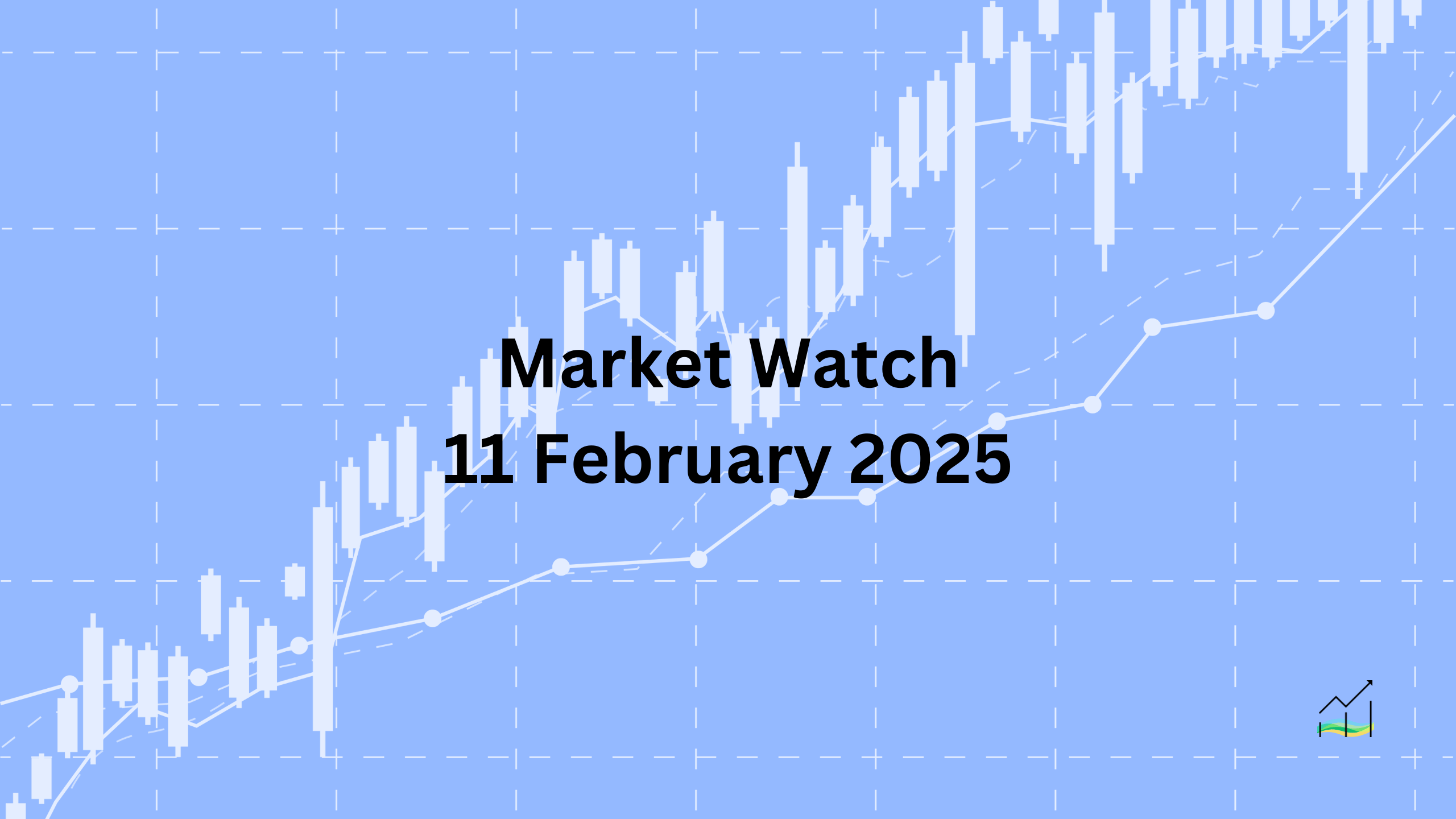11/02/2025 Market Watch

Tariff Uncertainty, Market Reactions & Key Developments
The US has announced that the 25% steel and aluminum tariffs will not take effect until March 12, reinforcing the view that they are being used as a negotiation tool. This delay may explain the relatively muted market reaction. Some analysts believe these broader tariffs aim to curb the re-export of Chinese steel, but they are unlikely to sit well with US allies. Historically, both Trump and Biden granted exemptions to these tariffs, leaving uncertainty about how the situation will unfold this time.
The US dollar is trading within a narrow range against G10 currencies, fluctuating by about ±0.15%. Most emerging market currencies are weaker, though a few from Central Europe have shown some resilience.
Equities are under pressure. Most major Asia-Pacific markets declined, with Hong Kong leading the losses at 1%. However, Taiwan and Australia managed to post slight gains. In Europe, the Stoxx 600 is down slightly, while US S&P 500 and Nasdaq futures have fallen by 0.4%-0.6%. Bond yields are also rising, with European benchmark yields climbing around five basis points. UK Gilts have seen a smaller increase of 2-3 basis points, similar to US Treasuries, placing the US 10-year yield at approximately 4.52%.
In commodities, gold initially reached a record high just below $2,943 before pulling back to test the $2,900 level, where buying interest is expected to emerge. Meanwhile, oil prices continue to climb. March WTI has risen for a third consecutive session, currently near $73.30 after hitting $70.40 before the weekend. The next technical resistance level is around $73.85.
United States of America
Overview
The US steel and aluminum tariffs, set to take effect on March 12, continue to shape market sentiment. While the one-month delay allows room for negotiations, it also explains the relatively subdued reaction so far. These tariffs introduce a potential supply shock at a time when the US economy is still growing above trend, keeping investors cautious.
Economic Drivers
The Federal Reserve’s stance remains a focal point. Fed Chair Powell is set to deliver his semi-annual congressional testimony on Wednesday and Thursday, reinforcing the message of patience. Given the economic conditions and policy adjustments, the Fed is reluctant to ease monetary restrictions further after cutting rates by 100 basis points in late 2024. The market remains uncertain about the future policy path, particularly with inflation and growth remaining resilient.
Data and Events
Before Powell’s testimony, the January CPI report will be released, providing fresh insight into inflation trends. Early expectations suggest inflation may remain stable on a year-over-year basis, which could influence market positioning ahead of the Fed’s testimony.
Price Action
The Dollar Index is trading within a narrow range of 108.20–108.45. A breakout above 108.60 could strengthen the dollar’s momentum, while a move below 107.70 would indicate further consolidation. Given the current market environment, investors appear more comfortable holding long dollar positions rather than risking losses on short positions.
Key Points:
- US steel and aluminum tariffs take effect March 12, keeping markets on edge.
- Fed Chair Powell is expected to emphasize patience in upcoming testimony.
- January CPI data, due before Powell’s speech, is projected to remain steady.
- The Dollar Index remains in a tight range; key levels to watch are 108.60 (breakout) and 107.70 (support).
Australia
Overview
After falling to a four-day low near $0.6230 due to US tariff concerns, the Australian dollar rebounded, reaching $0.6285 in the North American session. Despite this recovery, key resistance remains near $0.6300, which previously capped gains. A break above last month’s high (~$0.6330) is needed to shift the technical outlook.
Economic Drivers
The Australian economy is not expected to provide much support this week, as domestic data releases are minimal. Instead, market attention is on next week’s central bank meeting, where the swaps market is pricing in a 93% chance of a rate hike. Meanwhile, uncertainty lingers over the US tariff threat. Prime Minister Albanese mentioned potential US exemptions, but none have been confirmed.
Data and Events
The focus remains on next week's central bank meeting, where a rate decision will be closely watched. This week lacks significant Australian economic data, leaving external factors, particularly US trade policy, as the main market driver.
Price Action
The Australian dollar is trading in a narrow range above $0.6260. A push above $0.6300 is needed to sustain momentum, while a breakout past $0.6330 would strengthen the technical outlook.
Key Points:
- AUD rebounded from $0.6230 to $0.6285 but faces resistance at $0.6300.
- A break above $0.6330 is needed for a bullish shift.
- Australian data is light this week; focus is on next week's rate decision.
- Markets expect a rate hike (93% probability) despite US tariff risks.
- No exemptions for Australia from US metal tariffs have been confirmed yet.
Canada
Overview
The US dollar has established near-term support around CAD1.4270, with the Canadian dollar under pressure due to renewed US tariff concerns. While Canada may have temporarily eased tensions related to fentanyl and immigration, uncertainty over potential steel and aluminum tariffs remains a headwind.
Economic Drivers
In Trump's first term, Canada secured an exemption from US metal tariffs, but the risk of new measures continues to weigh on sentiment. The Canadian dollar recently fell to a four-day low, reflecting these concerns. Political uncertainty is also in focus, as leadership changes within the ruling party could impact market confidence.
Data and Events
Polls indicate that former Bank of Canada and Bank of England Governor Mark Carney is leading in the Liberal Party leadership race, with the decision set for next month. A strong result for Carney could help stabilize the minority government and delay an election, which must take place by late October at the latest.
Price Action
The Canadian dollar weakened as the US dollar touched its 20-day moving average near CAD1.4375. Currently, USD/CAD is trading within a narrow range of CAD1.4315–CAD1.4340.
Key Points:
- USD/CAD has near-term support at 1.4270.
- Canadian dollar weakened on US tariff concerns.
- Canada secured exemptions in Trump’s first term but remains vulnerable.
- Liberal Party leadership race next month could impact market sentiment.
- USD/CAD remains in a tight trading range near 1.4315–1.4340.
China
Overview
China has shown no intention of weakening the yuan to counteract US tariffs. The People's Bank of China (PBOC) continues to manage the exchange rate through its daily reference rate, maintaining a steady fix within a narrow range since January 21, apart from the Lunar New Year break.
Economic Drivers
The PBOC set today’s fix at CNY7.1716, the highest since January 20, signaling controlled adjustments rather than aggressive devaluation. Despite a stronger dollar reference rate, the offshore yuan has remained within yesterday’s range, showing no significant reaction to external pressures.
Data and Events
Since January 21, the PBOC’s daily fix has remained stable, fluctuating only slightly between CNY7.1696 and CNY7.1708. The latest fix, while slightly higher, still reflects Beijing’s preference for a controlled exchange rate environment rather than a currency-driven response to trade tensions.
Price Action
The dollar reached a four-day high against the offshore yuan yesterday but remains within a tight range of ~CNH7.3025-CNH7.3175. The middle of last week’s range stands around CNH7.3215, with potential upside toward CNH7.3330-50 if the dollar strengthens further.
Key Points:
- China is not devaluing the yuan to offset US tariffs.
- PBOC has kept the reference rate stable since January 21.
- Today’s fix at CNY7.1716 is the highest since January 20.
- Offshore yuan remains in a tight range (~CNH7.3025–CNH7.3175).
- A move above CNH7.3215 could open the door to CNH7.3330-50.
Europe
Overview
The euro initially rebounded from around $1.0140 last week, reaching a high of $1.0440. However, concerns over US steel and aluminum tariffs, coupled with potential EU retaliation, have pressured the currency lower. The euro has since pulled back to approximately $1.0280 and is holding above that level today.
Economic Drivers
The European Union has signaled possible retaliatory measures against the US tariffs, while the UK has stated it will not participate. This policy divergence adds another layer of uncertainty to euro price action.
Data and Events
This week’s economic calendar is relatively light, with most available data reflecting December figures. Given the recent release of Q4 GDP data, these reports may have limited impact on market sentiment.
Price Action
The euro is currently trading between $1.0290 and $1.0325, with key technical levels in focus. The 61.8% retracement of last week's rebound stands near $1.0255, which could act as a support zone. On the upside, resistance is expected around $1.0360-$1.0380, making a retest of higher levels challenging.
Key Points:
- The euro rebounded to $1.0440 but has pulled back to $1.0280.
- US tariffs on steel and aluminum are weighing on sentiment.
- The EU may retaliate, while the UK has opted out of such measures.
- A light economic calendar means little data impact this week.
- Support is at $1.0255, while resistance stands at $1.0360-$1.0380.
Japan
Overview
The US dollar has been trading within a narrow JPY151.00-JPY152.80 range over the past three sessions, currently fluctuating between JPY151.65 and JPY152.20. Despite a 5% pullback over the past month, rising US Treasury yields could provide renewed support for the greenback.
Economic Drivers
Higher US yields, particularly the 10-year yield attempting to reclaim its 4.50% level, may reinforce dollar strength. Meanwhile, Japan faces limited domestic economic catalysts until next Monday’s Q4 GDP release, which is expected to show growth around 0.3% quarter-over-quarter, similar to Q3 2024.
Data and Events
Japan's economic calendar is relatively quiet, with Q4 GDP as the next major data point. The recent meeting between Japanese Prime Minister Ishiba and US President Trump was seen as politically successful in Japan but failed to secure an exemption from US steel and aluminum tariffs.
Price Action
The dollar is holding within its recent range, with potential upside if Treasury yields continue rising. A break above JPY152.80 could open the door for further gains, while JPY151.00 remains a key support level.
Key Points:
- The dollar remains within JPY151.00-JPY152.80, with limited movement.
- US 10-year Treasury yield attempting to hold above 4.50%.
- Japan’s Q4 GDP release next week is expected to show 0.3% growth.
- US steel and aluminum tariffs apply to Japan despite diplomatic efforts.
- Key technical levels: JPY151.00 (support), JPY152.80 (resistance).
United Kingdom
Overview
The British pound slipped further today, reaching a six-day low just below $1.2335. It briefly fell under the 61.8% retracement level of its recent bounce but has since stabilized near $1.2365. Sterling had also closed below its 20-day moving average for the first time since January 23, signaling potential weakness.
Economic Drivers
Sterling’s movement reflects ongoing technical pressures rather than new fundamental drivers. The currency is testing key support areas, with traders closely watching the broader trend for further direction.
Data and Events
The key focus this week is on the UK’s Q4 GDP and December economic data, set for release on Thursday. These figures could influence expectations around future monetary policy and provide more clarity on the UK’s economic trajectory.
Price Action
Sterling is consolidating near $1.2365, with resistance at $1.2385. A key trendline from mid-January, late January, and early February lows suggests support around $1.2300. A break below this level could trigger further declines.
Key Points:
- Sterling hit a six-day low below $1.2335 before stabilizing.
- It briefly dropped below the 61.8% retracement level before recovering.
- Closed below the 20-day moving average for the first time since January 23.
- UK Q4 GDP and December economic data are due on Thursday.
- Key technical levels: $1.2300 (support), $1.2385 (resistance).
© 2025 SKONE Enterprise (003319453-V). All rights reserved.
The content on this site is for informational purposes only and does not constitute financial advice.


